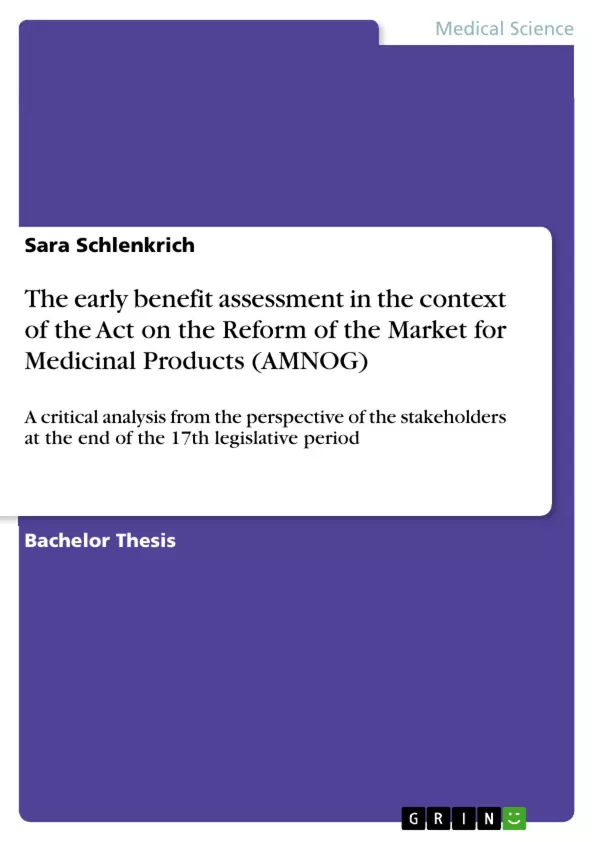The Act on the Reform of the Market for Medicinal Products, which entered into force on the 1st of January 2011, brought about a fundamental change in the balance of power on the pharmaceutical market. This thesis therefore sets out to answer the following question: What impact does the early benefit assessment in the context of the Act on the Reform of the Market for Medicinal Products have on the stakeholders of the healthcare system?
To answer this question, this work first presents the theoretical foundations of the law, of the early benefit assessment and the bodies involved. It then takes stock of the decisions taken to date before describing the impact on the selected stakeholders.
The following findings were reached: As the representative of the statutory health insurance funds, the Central Federal Association of Statutory Health Insurance Funds has gained in power and now decides, as a member of the Federal Joint Committee, on the added benefit of a drug and, depending on this decision, also on the future reimbursement rate. Pharmaceutical companies, however, are losing clout and must comply with the guidelines and assessments of the early benefit assessment. Patients stand to gain and lose out from the early benefit assessment. They are the ones who are ultimately dependent on the medicinal product and its improvement and benefit from a proven benefit. However, they have no say in the early benefit assessment procedure.
Inhaltsverzeichnis (Table of Contents)
- Introduction
- Scope
- The central research question
- Methodology
- The Act on the Reform of the Market for Medicinal Products
- The background of the Act
- The objectives of the Act
- The Federal Joint Committee (G-BA)
- The Institute for Quality and Efficiency in Healthcare
- The manufacturer dossier
- Early benefit assessment
- The special case of orphan drugs
- Evaluation, findings and experience – Critical analysis
- Evaluation of the added benefit classifications
- Methodology
- Frequency distribution of the added benefit categories
- Comparison of the added benefit classifications
- The impact on the statutory health insurance funds
- Overview of the statutory health insurance funds in Germany
- Challenges facing the health insurance funds
- The Central Federal Association of Statutory Health Insurance Funds
- The early benefit assessment from the perspective of the Central Federal Association of Statutory Health Insurance Funds
- The impact on the pharmaceutical industry
- The pharmaceutical industry in Germany
- A critical assessment from the perspective of the pharmaceutical industry
- The impact on patients
- Patient organisation in Germany
- A critical analysis from the patient's perspective
- Conclusion
- Summary and Outlook
Zielsetzung und Themenschwerpunkte (Objectives and Key Themes)
This thesis aims to analyze the impact of the early benefit assessment in the context of the Act on the Reform of the Market for Medicinal Products on the stakeholders of the healthcare system. The key themes explored in the work include:- The early benefit assessment process and its impact on the pharmaceutical market
- The role of the Federal Joint Committee (G-BA) in determining the added benefit of drugs
- The challenges faced by statutory health insurance funds in managing drug costs
- The perspective of the pharmaceutical industry on the early benefit assessment process
- The impact of the early benefit assessment on patients
Zusammenfassung der Kapitel (Chapter Summaries)
The first chapter provides an introduction to the thesis, outlining the scope, research question, and methodology. Chapter two explores the Act on the Reform of the Market for Medicinal Products, its background, objectives, and key stakeholders, such as the Federal Joint Committee and the Institute for Quality and Efficiency in Healthcare. It also delves into the early benefit assessment process and the special case of orphan drugs. Chapter three analyzes the evaluation and findings of the early benefit assessment, including the frequency distribution of the added benefit classifications and the impact on the statutory health insurance funds, the pharmaceutical industry, and patients.
Schlüsselwörter (Keywords)
The main keywords and focus topics of this thesis include the Act on the Reform of the Market for Medicinal Products (AMNOG), early benefit assessment, added benefit, statutory health insurance funds, pharmaceutical industry, patients, and the Federal Joint Committee (G-BA). The work also examines the impact of the early benefit assessment on the balance of power in the pharmaceutical market and the challenges of managing drug costs in the healthcare system.- Arbeit zitieren
- Sara Schlenkrich (Autor:in), 2013, The early benefit assessment in the context of the Act on the Reform of the Market for Medicinal Products (AMNOG), München, GRIN Verlag, https://www.grin.com/document/282129



